By Bernard E. Harcourt
A young philosopher standing in the back of the auditorium asked perhaps the most challenging question at the Praxis 7/13 seminar dedicated to the yellow vest movement. He was, not surprisingly perhaps, the only person in the room who openly professed that he’d worn the yellow vest at protests. His question stopped me in my tracks: if you don’t wear the yellow vest, if you’re just a fellow traveler, he said, then aren’t you ceding the ground to the Right? Aren’t you enabling the very thing you fear most—namely, that the yellow vest movement will get captured by the right-wing Rassemblement national?
I slowly started to formulate a response while others asked more questions. I would have ventured an answer to the young philosopher, but wanted to leave the last word to my guests, especially to Ludivine Bantigny who had given us so much hope—symbolized by that final photograph of the yellow vest with the word “Espoir” imprinted on it. Later, as we walked out of the auditorium together, and he began rolling his cigarette, I learned his name, Vincent Jarry.
Vincent Jarry’s question highlighted the fact that we—or perhaps I—have still not fully grasped what is at stake with leaderless social movements. We cling to antiquated or static notions of identity, or ideology, or party—or even static ideas of left and right. But we need, once and for all, to get beyond those outdated concepts when we confront the challenges of a leaderless movement. Jarry is right: the leaderless and open nature of new social movements today means that we either participate and thereby help give meaning to the movement, or leave the field open for others to define the movement. The very notion of an “identity” of the movement—especially a passive identity—is obsolete in today’s universe of leaderless protest. It is every one of us who is willing to march, to make a poster, to carry a banner, to write our revendications on a yellow vest, who effectively shape and give voice to the movement.
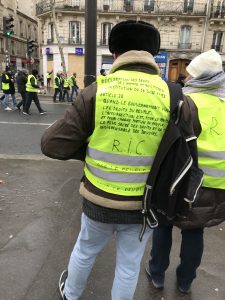
Yellow Vest protester at Act X, January 19, 2019, Boulevard St. Michel, Paris. © Bernard E. Harcourt
Judith Butler has written about the performative nature of assemblies, arguing that the physical gathering of bodies and the material element of assemblies precede, constitute, and make possible political expression. For Butler, the performative nature of assembly is a precondition for expression, and the materiality of assembly fashions the discursive realm. As Butler writes: “The assembly is already speaking before it utters any words […]. [B]y coming together it is already an enactment of a popular will. […] The “we” voiced in language is already enacted by the gathering of bodies, their gestures and movements, their vocalizations, and their ways of acting in concert.”[1]
I would push this one step further, or perhaps in a more concrete direction. The question is not just the enactment of a popular will. It is a question of who assembles and what they represent in being there. What kind of popular will: That is what matters, that is what is performed by participating in the social movement.
When a person dons the yellow vest, who they are and what they say have effects of reality. What they look like, their class appearance, their skin tone, their gender, their clothes—all of their appearance shapes the movement itself. The French flags and white faces on the Champs-Élysées at Acte IX, the very look on people’s faces in the défilé at Acte X, the presence or absence of minorities, the words on the back of the vests and on the front of the banners—all of which are determined by whether we are there or not—those constitute and transform, moment by moment, week by week, the trajectory of the movement.
Presence is a form of truth-telling, or what Foucault referred to as “veridiction.” It has real effects. It can be contested and, in the context of the yellow vests, it functions differently than the judicial words that J.L. Austin famously discussed—those illocutionary acts such as marrying or sentencing someone.
Contestation works differently here. At a recent yellow vest protest, some antifa protesters attacked and excluded right-wing, Action française yellow vest protesters. There is internal policing and exclusion. And when some yellow vest protesters claim to speak for others, routinely they are threatened and forced to step back. There is also a powerful dimension of authenticity associated with the social status of the person wearing the yellow vest. A protester who really has a hard time making ends meet at the end of the month has more legitimacy and authenticity than one who is well-off.
But within these constraints, the leaderless aspect of the movement allows for a truth-telling and –making. It makes possible a concrete, constitutive performativity. Wearing the yellow vest gives, or is the only way to try to give meaning to the movement.[2] Being a fellow traveler is impotent in that sense.
This contrasts sharply with more traditional political practice. Someone wearing, for instance, a France Insoumise T-shirt or carrying its flag is not able to refashion or shape the meaning and significance of that movement as easily by talking or by writing things on their vest. Jean-Luc Mélanchon is the one who will effectively define the party’s identity. Members can try to push and nudge and cajole. They can at times go ahead of their party or syndicates—as some workers did in France, in 1968, when they went on strike against the dictates of the CGT and other unions. But that will eventually catch up with them—as it did, precisely in 1968, when the CGT ordered the termination of the strikes (essentially at the behest of the Soviet Union). In a leaderless protest, by contrast, each individual constitutes and gives direction to the movement.
Everyone at Praxis 7/13—Etienne Balibar, Ludivine Bantigny, Toni Negri, and members of the audience—warned about, and feared a rightward drift of the yellow vest movement. That’s the looming threat and risk of the événement—that it might empower Le Pen’s Rassemblement national. And there are serious geopolitical concerns given the rise to power of the Five Star movement in Italy and of the ÖVP and FPÖ in Austria, Brexit, and the other right-ward drifts in Eastern Europe, Brazil, Turkey, India, the United States, and so on. But one of the only ways to avoid that is precisely, as Vincent Jarry suggested, to participate.
Chantal Mouffe argues, in her latest book (which we will be discussing on February 13, 2019), that left populism may offer far-right militants a new language and political register to express their grievances. It may be the only way, in fact, to swing those voters left. Mouffe notes that the France Insoumise party was able to draw some supporters from Marine Le Pen, and Jeremy Corbyn attracted a share of the right-wing UKIP votes—we might think here of the Trump-Sanders swing voters. Mouffe wagers that a conciliatory left populism, one that does not accuse but invites, might be able to win far-right votes. The truth, Mouffe contends, is that many on the far right are attracted to right-wing parties because they feel they are the only parties taking their concerns seriously. “I believe that, if a different language is made available, many people [on the populist right] might experience their situation in a different way and join the progressive struggle.”[3] Isn’t this yet another reason, then, to participate rather than to sit on the sidelines and judge the movement as a “compagnon de route” inevitably must?
As I returned to the yellow vest protest on Saturday, January 19, 2019, for what was called “Acte X,” I had a strange sensation that this is perhaps what is happening to the movement, at least in Paris. Whereas previously the Paris protests were less organized and clustered around the Étoile at the Champs-Élysées, Act X resembled a more traditional protest march, a more classic défilé on the Left Bank. It started at the Invalides and proceeded along the left bank of the Seine, down the Boulevard St. Michel to the Place d’Italie, toward more popular neighborhoods, and it felt like it contained more union members and Mélanchon supporters. Act X was dedicated to all the yellow vests who have died in the movement, and it resembled a more traditional cortège procession.
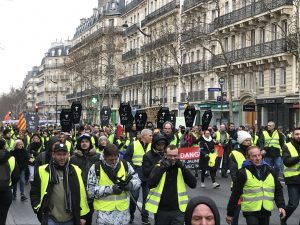
Yellow Vest cortège with coffins, Act X, January 19, 2019, Bd St. Michel, Paris. © Bernard E. Harcourt
At Act X, there were more militants with CGT logos, or France Insoumise logos, on their yellow vests. According to news reports, this was not the case in Toulouse, where the protests were far more chaotic and violent—and which has become, according to the media, the epicenter of the movement. In Toulouse, the demonstration hit a record number of 10,000 protesters (a record for Toulouse and more than in Paris, supposedly 7,000) and was marked by gas and water cannons. Similar problems occurred in Angers and elsewhere. But in Paris, the atmosphere was more subdued and orderly than before. Could it be that, in Paris at least, the traditional elements of the Left had begun to tame the yellow vest movement?
The Ministry of the Interior reported that Act X mobilized the exact same number of protesters as the week before—84,000 yellow vests.[4] The protests were scattered across the country, in Paris and Toulouse of course, but also in Bordeaux, Nancy, Rennes, Rouen, Caen, Lyon, Dijon, and elsewhere—the same day, incidentally, as the Women’s March in the United States. In Paris, the number of protesters reached 7,000 according to the French state, down from 8,000 the week before, but other and more cities saw increases. The count was a particular sensitive matter for both the state and the movement. The “grand débat” was launched on the previous Tuesday, January 15, 2019, and President Emmanuel Macron had spent a combined total of 13 hours responding to 1,200 mayors on Tuesday and Friday, January 15 and 18, 2019—in two, six-and-a-half hour marathons of questions-and-answers with 600 mayors in two different regions of France, Normandie and Occitanie. The big question on everyone’s mind was whether the launch of the national debate and President Macron’s 13 hours of face-time would dampen, assuage, or abate the yellow vest movement. To the surprise of many, it did not.
Once again, the police was there—and everywhere—in an overwhelming display of force. The French state, once again, mobilized and deployed 80,000 law enforcement officers, meaning that, if we take their numbers at face value, there was one police officer for every yellow vest. (Maybe they should have traded jerseys!) The sight of the police force was, once again, overwhelming.
Many questions are now swirling around the yellow vest movement and the national “grand débat.” There is growing controversy over the use of flashball weaponry, which has seriously injured protesters. There is also a big question as to whether President Macron will meet with ordinary citizens, or only elected representatives. There are a lot of stakes to that question, but what is for sure is that Macron’s meetings with mayors and other elected representatives may not appease the yellow vest movement because it remains very much targeted, precisely, at elected officials.
There are today great uncertainties about the future and potential trajectory of the yellow vest protest movement, as well as daunting questions about the future of French politics. It is a truly exceptional moment in France and in French history, somewhat inédit, marked by the spontaneous drafting of cahiers de doléances around the country, the triggering and hurried organization of a dizzying and vast national debate, and calls of all kinds for different and more radical political procedures. At Praxis 7/13 and elsewhere, Toni Negri and others have spoken of turning the French Assembly into an “assemblée constituante,” which would push the situation into even further uncharted territory. These are weighty matters that call for deep reflection and care. In the immediate, though, at least for me, the most punctual dilemma remains Vincent Jarry’s original question—one that raises critical questions of meaning, veridiction, performativity, and praxis. The question for today—to borrow Austin’s turn of phrase—is: How to do things with vests?
Notes
[1] Judith Butler, Notes Toward A Performative Theory of Assembly (2015), p. 156-157.
[2] Naturally, this raises myriad questions about meaning, interpretation, and representation, especially about the giving of meaning or the very possibility of giving meaning, about linguistic structuralism and who and how meaning emerges—important questions that would require lengthier treatment. There is of course much more to say, but that should not stop us in the urgency of this political moment in France. I earlier addressed many of these questions through a lecture croisée of Sartre, Lévi-Strauss, Bourdieu, and Butler in Language of the Gun (2007), some of which I took up again in an essay titled “An Answer to the Question: ‘What Is Post-Structuralism?’”
[3] Chantal Mouffe, For a Left Populism (2018), p. 22.
[4] What are the statistical odds of getting the exact same count two weeks in a row? And how come it is 84,000 both times, not rounded up to 85,000? The yellow vest movement is beginning to contest these numbers, but the media is surprisingly silent and, oddly, does not offer its own independent count. This surely will evolve over the next months, I would imagine.
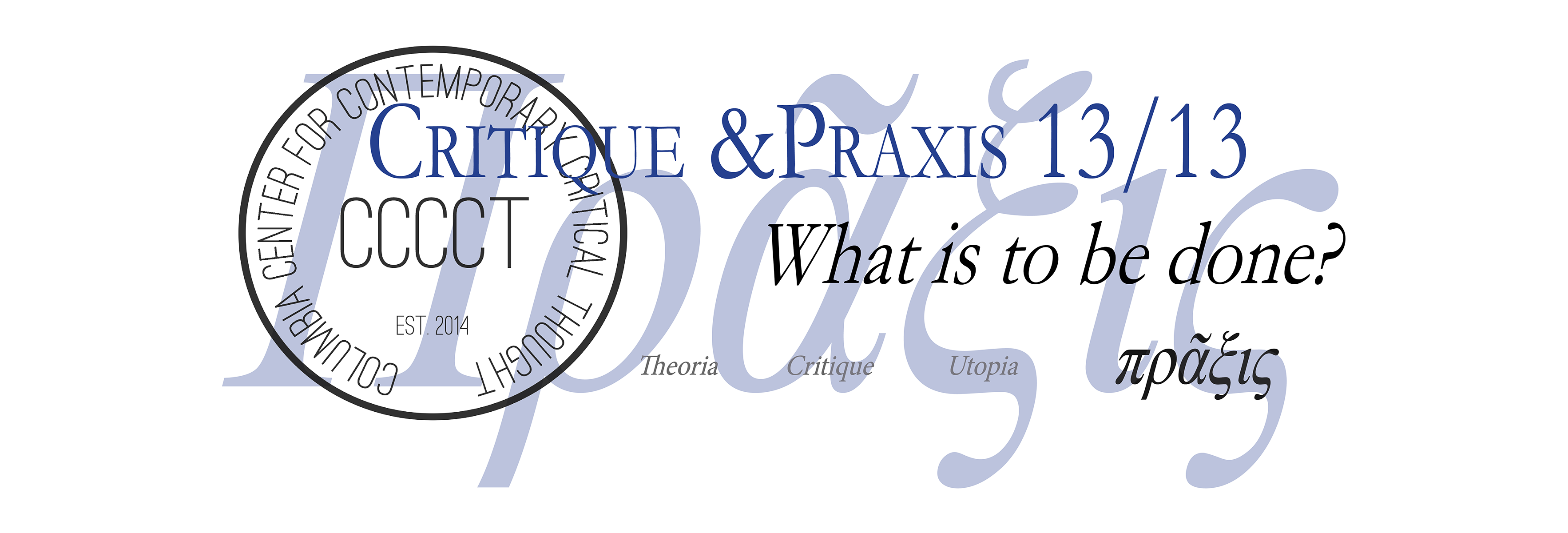

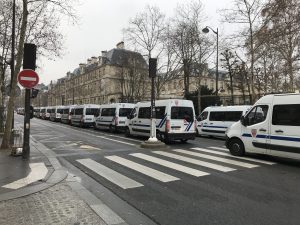
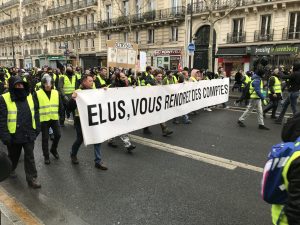
This apprehension regarding ‘rise of the rights’ is somewhat expressed in a recent IFOP survey (https://www.parismatch.com/Actu/Politique/Sondage-Ifop-dans-l-opposition-le-RN-plus-fort-que-LFI-1598416 ). And indeed the only way is really, as you suggested — “But one of the only ways to avoid that is precisely, as Vincent Jarry suggested, to participate.”